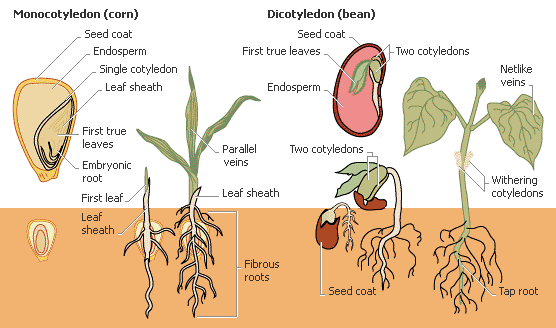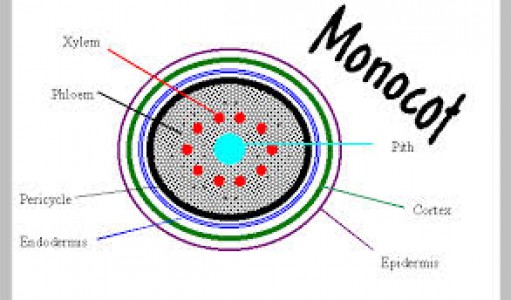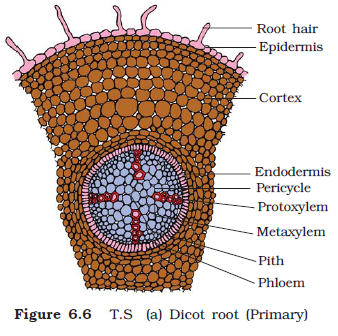Difference between Dicot and Monocot Roots

The term cotyledons refers to the seed leaves produced by an embryo during the germination process. Angiosperms are differentiated into two classes, “Monocots” and “Dicots”, based on the number of cotyledons found in the embryo of the seeds. As the name suggests, seeds of monocotyledonous flowering plants have only one cotyledon, while those of dicotyledonous plants have two.
The root structure of the seedlings that sprout from monocot and dicot seeds differ considerably. In most dicotyledonous plants, the root develops from the posterior end of the embryo, called “radical”. The radical develops into “apical meristem”, which then produces roots tissues. In case of Monocots, the radical aborts and new roots develop adventitiously from nodes on the stems. The resulting roots are called prop roots when they combine together to form a bunch near the bottom of the stem.
Cortex of monocot roots is wide while that of the dicot roots is comparatively narrower. The pericycle of monocots is usually multilayered, while in case of dicots, it is always single layered. The pericycle of the former produces lateral roots only, while the pericycle of the latter produces cork cambium as well. Monocots have a fibrous root system, while dicots have a taproot system.
Vascular bundles in monocot roots are always more than six in number, whereas the vascular bundles of dicot roots range from two to six in number. Xylem vessels are oval and rounded in case of monocots, while they are angular in case of dicots. Pith is always well developed in the former, whereas in the latter it is not properly developed and can be absent. Secondary growth takes place in all dicot roots, on the other hand, in monocot roots, secondary growth never takes place.
Dicotyledons have floral parts (petals, stamens etc) in multiples of three, usually three or six, whereas dicot flowers tend to have a number of parts that is divisible by four or five, like four, five, eight, ten etc. In monocots, the leaf veins are parallel, while in dicots they are branched (reticulated).
Instructions
-
1
Monocot roots
The root system that develops from monocotyledonous seeds is termed as the monocot root system. Grains (wheat, corn, rice), banana, ginger, onion, sugarcane, lilies, daffodils, palm tree, are all examples of monocotyledonous angiosperms.
Image courtesy: biology.kenyon.edu
-
2
Dicot roots
The root system that develops from dicotyledonous seeds is called the dicot root system. All legumes (pea, beans, lentils, peanuts), lettuce, mint, daisies, tomato and oak tree are examples of dicotyledonous plants.
Image courtesy: textbook.s-anand.net







